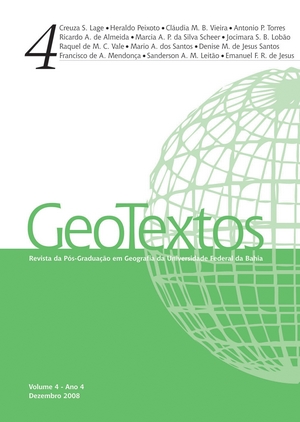GEOPROCESSING AND SHIFT-SHARE MODEL APPLIED FOR ANALYSIS OF THE LAND COVER TRANSFORMATIONS IN MOGI GUAÇU’S DRAINAGE BASIN BETWEEN 1979 AND 2001
DOI:
https://doi.org/10.9771/1984-5537geo.v4i0.3296Keywords:
Shift-share model, Landsat’s images, Geographic Information System, Agricultural productionAbstract
This research had identified the main factors which influenced the changes of the land use in the localities along of the Mogi Guaçu’s drainage basin between 1979 and 2001. This area is located in a strategic geographical region and has an important role for agricultural production the sugar cane at the state, national and international levels. Our study have followed three steps, the first one elaborated a database with the results of the Shift-Share model applied to the statistic data, collected from the Annual Agricultural Production Report in Municipal Scale, by Brazilian Institute of Geography and Statistics (IBGE). The second step have consisted in elaborating a Spatial Database with the multitemporal analysis of the land use in agricultural areas of five localities inside the drainage basin studied (Barrinha, Dumont, Jaboticabal, Pitangueiras, Santa Lúcia and Sertãozinho using satellite images of LANDSAT 2-MSS (1981); LANDSAT 5-TM (1990) and LANDSAT 7-ETM+ (2001). The integration and comparison of the results was the third step of this research, making possible the analysis of land use changes and agricultural production for the studied drainage basin. The results had evidenced that the Shift-share model and geoprocessing are complementary. In the study area the expansion of agricultural production occurred mainly by the substitution of smaller fields of non-profitable agricultural crops by a large sugarcane cultivated area and also, by more intensive agricultural use of the land.Downloads
Downloads
Published
How to Cite
Issue
Section
License
Autores que publicam nesta revista concordam com os seguintes termos:
Autores mantém os direitos autorais e concedem à revista o direito de primeira publicação, com o artigo simultaneamente licenciado sob a Licença Creative Commons Creative Commons CC BY que permite o compartilhamento do trabalho com reconhecimento da autoria e publicação inicial nesta revista. Esta licença permite que outros distribuam, remixem, adaptem e criem a partir do seu trabalho, mesmo para fins comerciais, desde que lhe atribuam o devido crédito pela criação original. É a licença mais flexível de todas as licenças disponíveis. É recomendada para maximizar a disseminação e uso dos materiais licenciados. Ver o resumo da licença em: https://creativecommons.org/licenses/by/4.0/ Ver o texto legal da licença em: https://creativecommons.org/licenses/by/4.0/ Consulte o site do Creative Commons: https://creativecommons.org/licenses/?lang=pt
Autores têm autorização para assumir contratos adicionais separadamente, para distribuição não-exclusiva da versão do trabalho publicada nesta revista (ex.: publicar em repositório institucional ou como capítulo de livro), com reconhecimento de autoria e publicação inicial nesta revista.
Autores têm permissão e são estimulados a publicar e distribuir seu trabalho online (ex.: em repositórios institucionais ou na sua página pessoal) a qualquer ponto antes ou durante o processo editorial, já que isso pode gerar alterações produtivas, bem como aumentar o impacto e a citação do trabalho publicado (Veja O Efeito do Acesso Livre).






